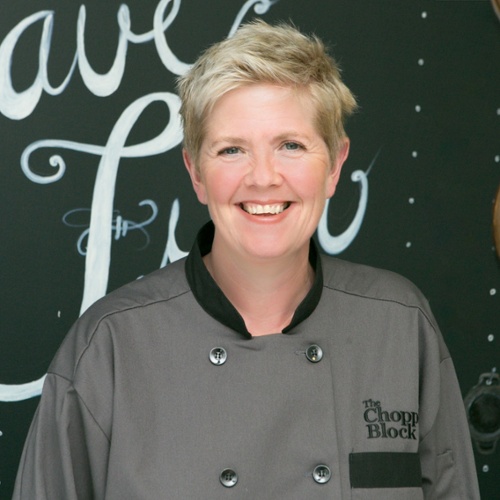I graduated from culinary school in 1986, and one of the essential cooking skills I learned was how to cook rice. Cooking rice was formula driven which made it incredibly simple to understand and remember: to 1 part long grain rice, add 2 parts water or stock and bring it to a boil. Reduce the heat to low, cover the pot with a tight-fitting lid and cook for 15 minutes without lifting the lid. That’s it - simple as can be.
In 1987, I moved to San Diego and met my dear friend Liz Bernal, who grew up eating rice every day and showed me how to make sticky rice. This was new to me, and I found it to be an even easier method than what I had learned in culinary school. I learned three new techniques from Liz for cooking rice.
- Rinse your rice
There are conflicting points of view about whether to rinse rice, but I personally believe the benefits outweigh the negatives. The reason we rinse rice is to remove the extra starch on the outside of the rice. That extra starch, vitamins and other matter add a layer of starchiness, not necessarily the kind of starchiness we want, but more of a gluey texture. The only reason not to rinse rice is because you don’t want to rinse off the vitamins that many white rice varieties are enriched with or because you are going to sauté/toast the rice before cooking and you don’t want the added moisture.
When I make a pilaf, paella or risotto I always start by sautéing the rice. This process toasts the exterior of the rice grain, and this works better when the rice isn’t wet. The toasting seems to remove the gluey quality of the starch on the outside of the rice.
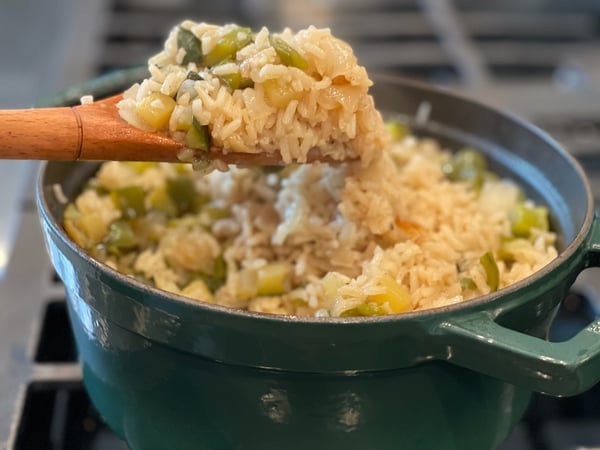 Rice Pilaf
Rice Pilaf
- Measuring without measuring cups
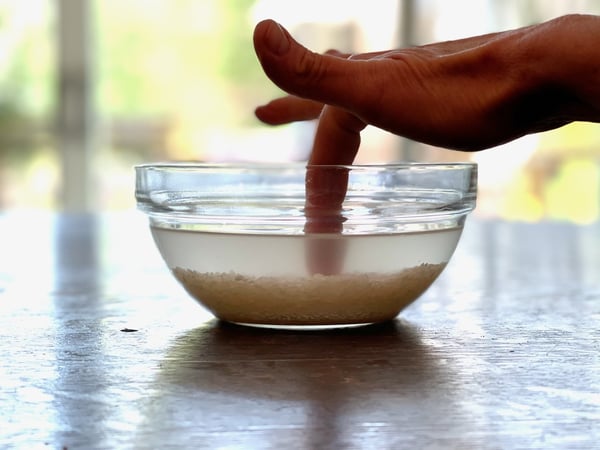
Liz’s method removed the need to measure in a conventional way: just rinse your rice and put it in the rice cooker, add enough water to reach the first knuckle of your finger. When using this measuring technique, it doesn’t matter if you are cooking 1 cup or 20 cups, cooking rice on the stovetop or in a rice cooker, this technique works every time… except for aromatic rice. Aromatic rice you should measure out 1 cup of rice to 1 ½ cups of water.
- Rice cookers are awesome

Rice cookers remove the need to know how long to cook rice, because they do the timing for you. Add water and rice to the rice cooker and turn it on, bam, you’re done. The rice cooker turns itself off when the rice is done and holds it perfectly cooked until you are ready to eat! My rice cooker is at least 20 years old, and I probably paid 20 bucks for it then. If you cook a lot of rice, this appliance is completely worth the investment.
35 Years Later
Being raised in the Midwest, potatoes were our mainstay. My exposure to rice was having it made into pudding or stuffed into a pepper, and that was pretty much it. The lessons I learned in culinary school and from Liz really got me through most of my culinary career. I felt like I had the rice thing down, but here we are in 2021, 35 years later, and I am still learning about rice. Back then, all the local grocery store carried was long grain rice, but today the varieties of rice that are available is staggering.
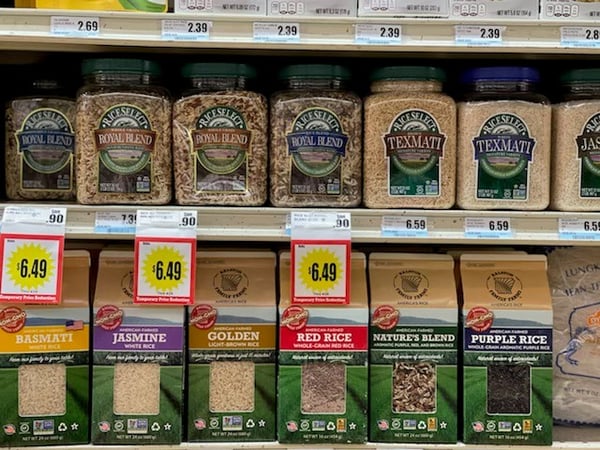 Did you know that there are 120,000 varieties of rice? Thankfully, I don’t think there are 120,000 ways to cook rice, but there are countless techniques and contradictory opinions of how to do it. So much so that I think it has made the process of cooking rice seem daunting and perhaps has made you start to question what you already knew?
Did you know that there are 120,000 varieties of rice? Thankfully, I don’t think there are 120,000 ways to cook rice, but there are countless techniques and contradictory opinions of how to do it. So much so that I think it has made the process of cooking rice seem daunting and perhaps has made you start to question what you already knew?
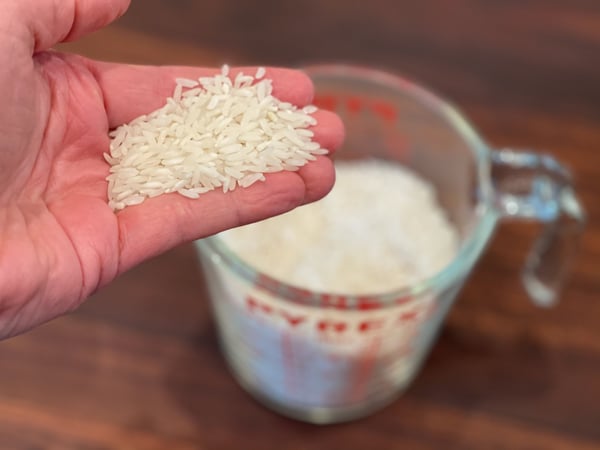 That is one reason I wanted to start this blog with the tried-and-true techniques I learned early on in my career. Those techniques are still pertinent, and you can still cook a great batch of rice with the two simple methods I outlined. To provide you the most current information on how to cook rice, I really need to share a bit more information. We need to discuss rice varieties and characteristics, soaking rice and cooking times.
That is one reason I wanted to start this blog with the tried-and-true techniques I learned early on in my career. Those techniques are still pertinent, and you can still cook a great batch of rice with the two simple methods I outlined. To provide you the most current information on how to cook rice, I really need to share a bit more information. We need to discuss rice varieties and characteristics, soaking rice and cooking times.
As always, my objective is to simplify the process versus overwhelm you with information. Instead of focusing on 120,000 varieties of rice and the many different theories on how to cook them, I will focus on the three most common varieties of rice used today.
Short Grain Rice: Sushi, Arborio, Sticky Rice
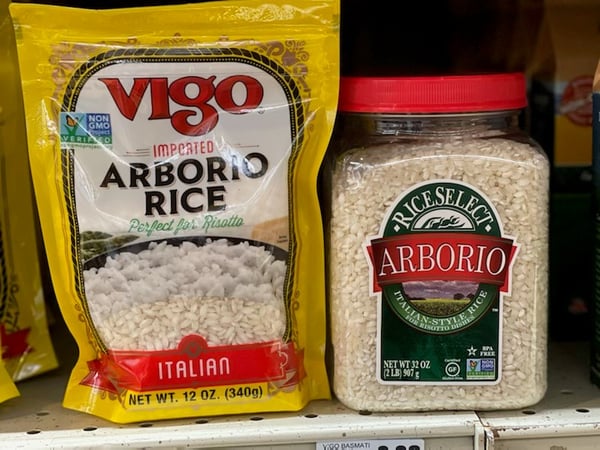 Short grain rice is about as wide as it is long. The shorter the grain of rice, the higher the starch content. The higher the starch content, the stickier the rice. Sticky rice can sound like an inherently bad thing when it comes to rice but sticky and gluey are very different. Sticky rice is what holds your sushi roll together. Sticky rice is what holds the sweet, salty and savory teriyaki sauce to the rice. Sticky rice is what adds the velvety texture to your risotto. That extra starch in the rice, if properly cooked, should add a stickiness not a glueyness.
Short grain rice is about as wide as it is long. The shorter the grain of rice, the higher the starch content. The higher the starch content, the stickier the rice. Sticky rice can sound like an inherently bad thing when it comes to rice but sticky and gluey are very different. Sticky rice is what holds your sushi roll together. Sticky rice is what holds the sweet, salty and savory teriyaki sauce to the rice. Sticky rice is what adds the velvety texture to your risotto. That extra starch in the rice, if properly cooked, should add a stickiness not a glueyness.
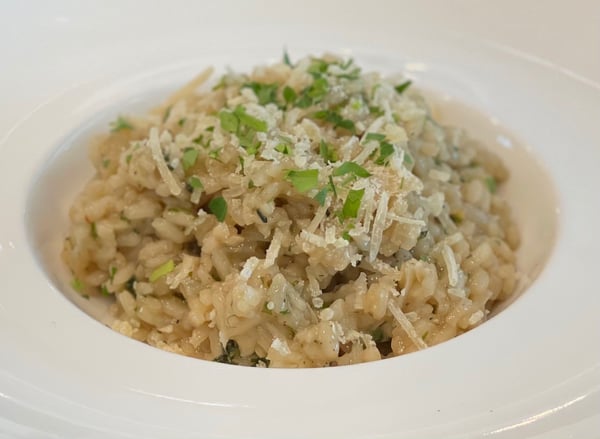 Risotto
Risotto
Aromatic Rice: Jasmine, Basmati, Texmati and Jasmati
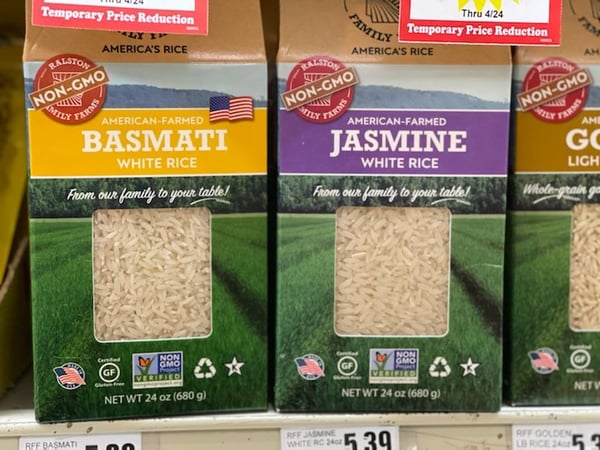
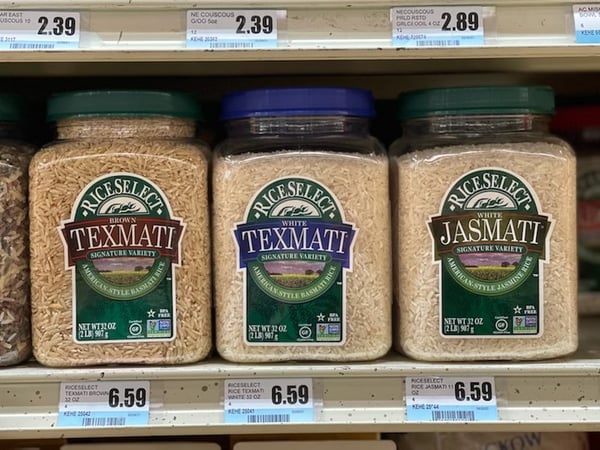 The name aromatic accurately describes the aroma and flavor of this type of rice. The aromatic quality of this rice compliments aromatic cuisines such as Thai and Indian. Of course, its beautiful flavor and aroma compliment any meal in which you want the rice to shine. Although aromatic rice is technically a long grain rice, it has a much lower starch content and a finer grain than regular long grain rice.
The name aromatic accurately describes the aroma and flavor of this type of rice. The aromatic quality of this rice compliments aromatic cuisines such as Thai and Indian. Of course, its beautiful flavor and aroma compliment any meal in which you want the rice to shine. Although aromatic rice is technically a long grain rice, it has a much lower starch content and a finer grain than regular long grain rice.
Aromatic rice naturally separates during cooking due to its low starch content. The grain is smaller in circumference and slightly more porous making the grains more susceptible to breaking or over cooking. To keep from overcooking, aromatic rice varieties all require less liquid than all other varieties of rice: 1 cup of rice to only 1 ½ cups of liquid. When these delicate grains of rice are cooked perfectly, they create more of a web of rice. The grains are much more independent than short grain rice but yet connected enough to hold onto a rich and velvety Massamam curry sauce or a spicy Tom Yum Gai soup and delicate enough to create a fluffy and light rice pilaf.
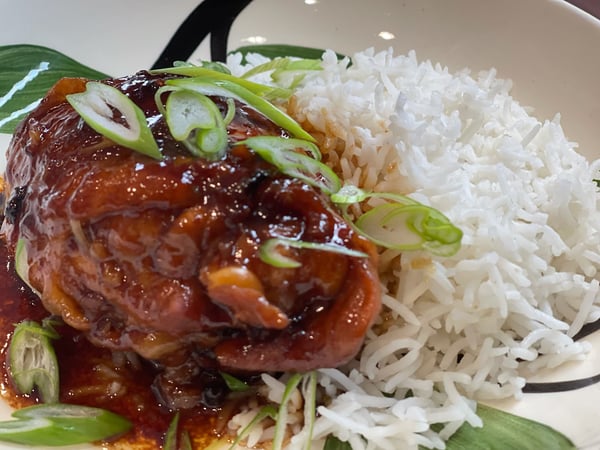
Long Grain Rice: White Rice
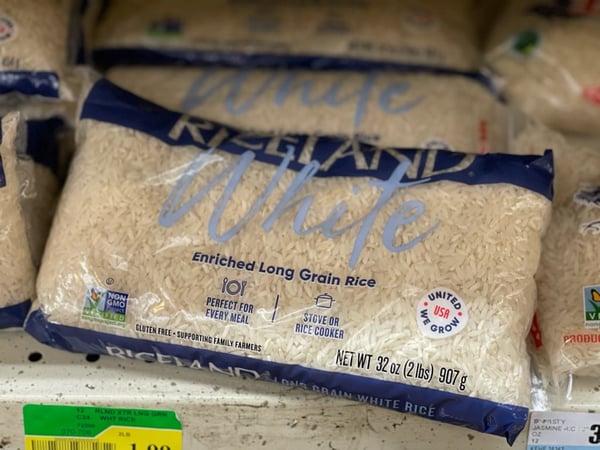 Long grain rice accounts for 75 percent of the rice produced in the US. The grains are 4 to 5 times as long as they are wide. This rice has a medium starch content and when cooked properly should be fluffy and dry with separate grains. This rice has a sturdiness compared to aromatic rice so it works well in soups, as an element in a dish like the stuffed peppers or in a casserole and it stands up to sautéing like in the case of fried rice. Long grain rice is a more neutral tasting rice compared to the aromatic varieties so it is great for highly seasoned recipes or where you want the rice to be in the background of a meal.
Long grain rice accounts for 75 percent of the rice produced in the US. The grains are 4 to 5 times as long as they are wide. This rice has a medium starch content and when cooked properly should be fluffy and dry with separate grains. This rice has a sturdiness compared to aromatic rice so it works well in soups, as an element in a dish like the stuffed peppers or in a casserole and it stands up to sautéing like in the case of fried rice. Long grain rice is a more neutral tasting rice compared to the aromatic varieties so it is great for highly seasoned recipes or where you want the rice to be in the background of a meal.
Soaking Rice
I want to start by saying I personally feel like soaking rice is an option. You can make great rice without soaking it, but if you want to create the ultimate rice, soak it. Soaking rice is just one of the tricks to keeping rice just the right amount of sticky. Soaking any variety of rice covered in water for just 30 minutes plumps the grains of rice. This plumping allows the grains to absorb a little water prior to cooking, the grains of rice will be very tender without getting mushy and the rice cooks very evenly. This plumping creates a more independent grains as well as keeping the grains of rice from breaking down during cooking.
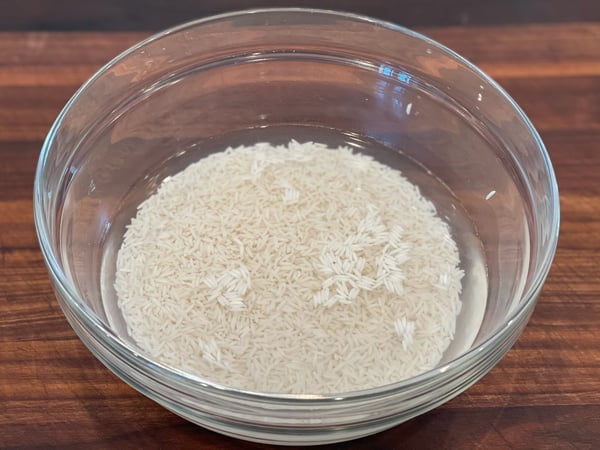 You may hear that soaking rice cuts down on the cooking time. I find that a short soaking, just 30 minutes doesn’t alter cooking times. I don’t cut down on cooking time if I'm just soaking for 30 minutes. You need to soak rice for 6 to 24 hours to cut down the cooking time, and even with overnight soaking the most you can reduce cooking is perhaps 10 minutes like in the case of brown rice. I personally haven’t found that overnight soaking really changes the cooking time that much. I did a test batch of Basmati rice where I soaked it for three days, and it cooked perfectly but still took 15 minutes to cook. An overnight soak does reduce the water you need to cook the rice, you’ll need to reduce the water by 1/2 cup. That overnight soaking yields rice that cooks extremely evenly.
You may hear that soaking rice cuts down on the cooking time. I find that a short soaking, just 30 minutes doesn’t alter cooking times. I don’t cut down on cooking time if I'm just soaking for 30 minutes. You need to soak rice for 6 to 24 hours to cut down the cooking time, and even with overnight soaking the most you can reduce cooking is perhaps 10 minutes like in the case of brown rice. I personally haven’t found that overnight soaking really changes the cooking time that much. I did a test batch of Basmati rice where I soaked it for three days, and it cooked perfectly but still took 15 minutes to cook. An overnight soak does reduce the water you need to cook the rice, you’ll need to reduce the water by 1/2 cup. That overnight soaking yields rice that cooks extremely evenly.
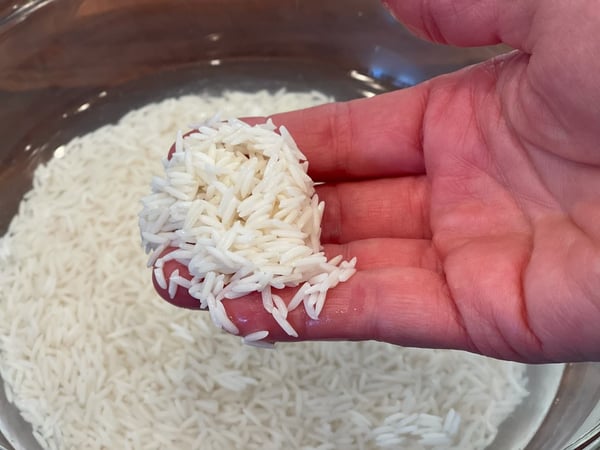 What I like to do is to measure 1 part rice or 1 cup of rice right into the pot I am going to cook the rice in. Rinse the rice until the water runs clear. Measure by 2 cups of water (or 1 1/2 cups for aromatic rice) and add to the rice. Just let the rice sit on the stove for 30 minutes. Then proceed as you would with normally, bring the water to a boil, reduce heat to low, cover with a tight-fitting lid and cook for appropriate amount of time (see chart below), turn of the heat and let finish cooking in the pot without the heat on for five to ten minutes.
What I like to do is to measure 1 part rice or 1 cup of rice right into the pot I am going to cook the rice in. Rinse the rice until the water runs clear. Measure by 2 cups of water (or 1 1/2 cups for aromatic rice) and add to the rice. Just let the rice sit on the stove for 30 minutes. Then proceed as you would with normally, bring the water to a boil, reduce heat to low, cover with a tight-fitting lid and cook for appropriate amount of time (see chart below), turn of the heat and let finish cooking in the pot without the heat on for five to ten minutes.
Soaking rice also has health benefits, according to many experts. It is said that the soaking helps to retain the nutritional value of the rice. I personally can’t speak to the science behind this, but there are a ton of articles on the subject online if you want to explore that conversation.
Rice Cooking Times
Whether using long grain rice, short grain rice or aromatic rice, the stovetop method for cooking rice I outlined at the beginning of this article holds true.
Here is a general chart for cooking times. I recommend reading the packages of rice for cooking times because these can vary by brand.
- Aromatic rice: 15 minutes cooking over low heat, 5 to 10 minutes resting without heat
- Long grain rice: 15 minutes cooking over low heat, 5 to 20 minutes resting without heat
- Short grain rice: 20 minutes cooking over low heat, 5 to 10 minutes resting without heat
- Brown rice: 30 minutes cooking over low heat, 5 to 10 resting without heat
There are many ways to yield great rice. Sometimes we are in a hurry on a weeknight, and sometimes we want to labor over a special dinner. The great thing about rice is its flexibility not only in cooking techniques but also in its ability to be both the star of the meal as well as play a supporting role.
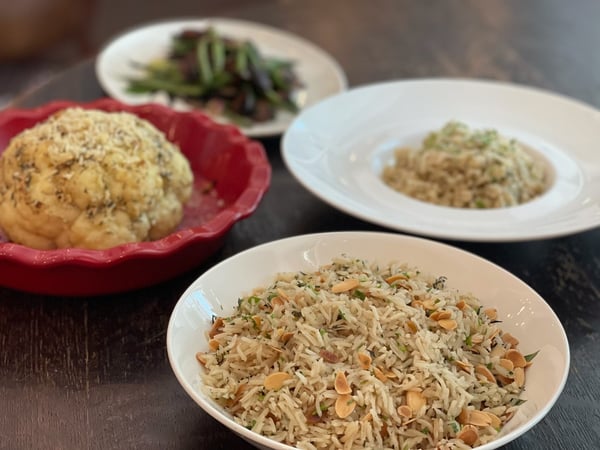
We have a virtual class that goes in-depth on rice cookery, so if you want to learn more, don't miss our Virtual Building Blocks: Vegetable and Rice Cookery on Saturday, June 5 at 10am CST. You'll learn how to make all of the delicious dishes in the photo above:
- Whole Roasted Cauliflower
- Sautéed Green Beans and Mushrooms
- Herb Risotto
- Basmati Rice Pilaf
If you want to have a live conversation on cooking risotto, join us this Friday, April 30 for our Virtual Vacation: A Trip to the Adriatic Coast at 7pm CST. You'll learn how to make a fun and delicious version of risotto featuring squid!
- Radish-Cucumber Salad with Citrus and Parsley
- Squid Ink Risotto with Calamari
To master cooking sushi rice, join us for a virtual Sushi Workshop this Saturday, May 1 at 6pm CST. You'll learn how to prepare and season sushi rice and turn it into some amazing rolls:
- Maki Rolls
- Inside-out Maki Rolls
- Spicy Tuna
- Nigiri
If you are looking for a fun new rice recipe to try, our virtual Sunday Dinner: Arroz con Pollo on Sunday, May 2 at 4pm CST. This dish is all about perfectly steamed rice!
- Arroz con Pollo (Chicken and Rice)
- Hearts of Palm and Avocado Salad
And if Indian flavors appeal to you, practice those aromatic rice skills in our Virtual Indian Vegetarian class on Thursday, May 6 at 6pm CST.
- Spicy Chickpea Curry with Steamed Basmati Rice
- Chapati (Whole Wheat Flatbread)


